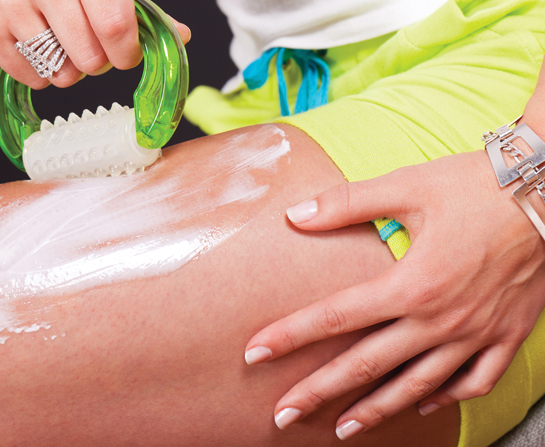Yikes! It’s cellulite!
May 1, 2022 Return

Zits and now, cellulite? That’s preposterous! Yes, cellulite is the slight bulge you see on your thighs, hips, buttocks and abdomen. Some called it the “orange-peel”; it commonly affects adolescent and adult women. And, it is downright unsightly! I mean, how are you going to boast of your slim body if cellulite is in sight?
What is cellulite?
Cellulite is not harmful. It is simply unattractive dimpled-fat-lump that most women wish to be rid of. Cellulite is commonly found in body parts with fat reserves such as thighs, hips, and buttocks. What happens is that the tissues connecting the fats to the muscles change their positioning between layers of various tissues. Called septa, the connective tissues may stretch, break down or pull tight. Under this condition, the fat bulges out near to the skin surface and bam, cellulite! It can happen to anyone regardless of age, gender, and body size.
Here are the 3 grades of cellulite.
- Grade 1: No visible cellulite observed, but a microscopic cell examination can identify the changes.
- Grade 2: No visible cellulite observed. But, an “orange peel” texture is observed when the skin is pinched.
- Grade 3: Cellulite is visible with rough skin texture along with Grade 2 signs. But, it may disappear when lying down.
What causes it?
There are some theories that can perhaps explain its occurrence:
- Hormones: Hormones such as oestrogen and prolactin are believed to play a role in cellulite production. Low levels of oestrogen, for instance, are associated with cellulite development.
- Genes: Certain genes can contribute to cellulite development. These genes affect characteristics associated to cellulite production such as gender, race, slow metabolism, and fat distribution.
- Hereditary: Your risk of cellulite is increased if your mother or grandmother has them too.
- Diet: People who consume too much fat, carbohydrates, high-sugar products, salt and too little fibre have higher risk of developing cellulite., Dehydration seems to play a role too.
- Lifestyle: Cellulite is more likely to happen to those who are inactive, smoke and sit or stand in one position for long periods.
- Age: Yes, age can be a factor. As a woman ages, her body produces less oestrogen and this can lead to of cellulite formation. Plus, the skin loses its elasticity overtime.
What can you do?
Lose some kilos:
- Regularly perform exercises that involve muscle strengthening in the legs, thighs, buttocks and abdomen.
- The firming and toning of the muscles will tighten the skin over time; hence creating the illusion that cellulite is not present.
- Practise strength training moves such as lunges
A healthy diet:
- Eat a well-balanced diet –especially plant-based foods–to improve your unsightly “orange peel”.
- Eat fruits and vegetables which contain more than 90% water such as cucumbers, radishes, tomatoes and bell peppers
- Consume anti-oxidant rich foods such as berries and red kidney beans.
- Reduce intake of refined, processed and artificial foods that contain sweeteners, additives and chemicals.
- Cut down on dairy, high-fat products and sugary products.
- Stay hydrated
Surgical and lasering treatment:
If you’re looking to remove cellulite, consult a dermatologist. Here are some options you can take to remove cellulite.
- Laser and radio-frequency treatment:
- Stimulates collagen production.
- Alters the septa so that they do not cause dimples and hence, no more cellulite.
- May require 1 or 2 maintenance treatments per year to remove cellulite.
- Laser-assisted liposuction:
- Destroys fat cells and tightens the skin
- May take up to 6 months for the skin to tighten around the treated area
Should I use…?
Take caution if you plan to use alternatives such as cellulite creams as they may not be effective. Some common ones are:
Cellulite creams
There are no proven studies to prove their efficacy. They usually contain a mixture of ingredients such as vitamins, minerals, herbal extracts and antioxidants that are said to improve cellulite. When used, it can cause skin rashes or allergic reactions in some people.
Mesotherapy
This involves injection of substances such as enzymes, vitamins, and amino acids into the tissues below the skin. It may bring slight improvement to cellulite. But it can also cause infection or swelling.
Massage and spa treatments
This form of treatment offers temporary effects and do not remove cellulite.

References:
Harlow, C.R., et al. (2007). Oestrogen formation and connective tissue growth factor expression in rat granulose cells. Journal of Endocrinology. 192(1), 41-52
Health. Available from www.health.com
Healthline. Available from www.healthline.com
Mayo Clinic. Available from www.mayoclinic.org
Medical News Today. Available from www.medicalnewstoday.com
MedicineNet. Available from www.medicinenet.com
MedlinePlus. Available from www.nlm.nih.gov/medlineplus
WebMD. Available from www.webmd.com
If you like this article, do subscribe here.
